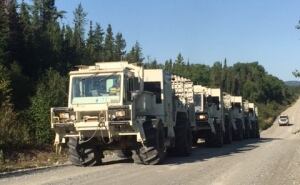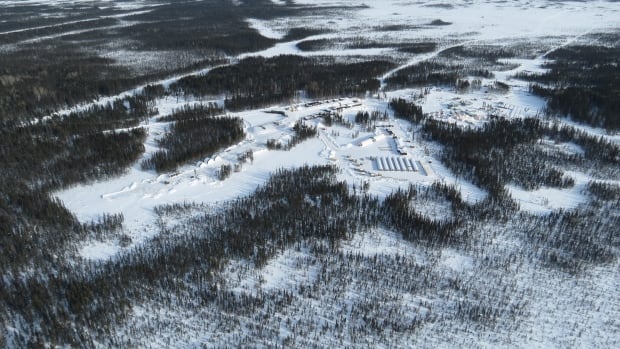Seismic testing to uncover mineral potential in resource-rich regions
posted on
Oct 24, 2017 07:35AM

NI 43-101 Update (September 2012): 11.1 Mt @ 1.68% Ni, 0.87% Cu, 0.89 gpt Pt and 3.09 gpt Pd and 0.18 gpt Au (Proven & Probable Reserves) / 8.9 Mt @ 1.10% Ni, 1.14% Cu, 1.16 gpt Pt and 3.49 gpt Pd and 0.30 gpt Au (Inferred Resource)

From 2016....
Ryan Weston, the vice-president of exploration at NorOnt expects the new Metal Earth project at LaurentianUniversity to help move the Ring of Fire project forward. (NorOnt)
Noront Resources is one of the mining companies backing the project. It has several claims in the Ring of Fire region of northern Ontario.
================================================
http://www.cbc.ca/news/canada/sudbury/sudbury-seismic-testing-merc-1.4368314
By Angela Gemmill, CBC News Posted: Oct 24, 2017 6:00 AM ETLast Updated: Oct 24, 2017 6:00 AM ET
The data collection for the Metal Earth Project involves vibration trucks which send out seismic waves. Those waves reflect off features in the earth's crust and then back to receivers or geophones that have been spread out 20 to 30 metres apart along the roadway. (Mining Exploration Research Centre at Laurentian University)
|
0 shares
|
||||
|
||||
|
||||
|
||||
|
||||
|
||||
|
Angela Gemmill
Journalist
The large trucks seen recently along major roadways in Sudbury are conducting seismic testing.
It's all part of a major research project by Laurentian University.
That seismic testing is not to detect natural or man-induced mining seismic activity, rather the testing is similar to sonar or ultrasound, says Harold Gibson, director of the Metal Earth Project.
The vibration trucks send out seismic waves, which reflect off features in the earth's crust and then back to receivers or geophones that have been spread out 20 to 30 metres apart.
The data is compiled into a seismograph showing 40 kilometres below the surface of the earth.
"To get an impression of what does [the] earth's crust look like in these metal-endowed areas versus what the earth's crust and mantle look like in less-endowed areas, to see what the differences are. So we can understand the processes of metal enrichment and understand better where our resources are," says Gibson.
The $104 million dollar, 7-year study is a massive development project led by the Mining Exploration Research Centre (MERC) at Laurentian.
Laurentian University receives $104M investment for mineral exploration research
Metal Earth project at Laurentian University could help Ring of Fire move forward
"This is a major research initiative that has never been undertaken before."
Gibson says funding for the project is from the Canada First Research Excellence Fund and Laurentian University. They also have 22 additional partners from academia, industry and government.
The project will involve training 30 postdoctoral fellows, 80 Masters and PhD grad students and 105 Bachelor of Science students.
Right now the researchers are in the data collection phase of the project.
According to Gibson, they've already conducted similar seismic surveys in Quebec and northeastern Ontario. They be in Greater Sudbury until the end of October before moving on to northwestern Ontario in November.
The seismic survey will focus on Quebec and Ontario for now, but Gibson says there are plans to further expand over the next year or two.

Vibrator seismic trucks are being used along major highways in Greater Sudbury until the end of October, as part of a massive research study called Metal Earth Project. (supplied)
Those who live near where the seismic testing is underway in Sudbury shouldn't be concerned, Gibson says.
There is traffic control around the vibration trucks. The receivers are small red and orange boxes set out along the roadside.
"These are recording the vibrations that are reflected back from different features within the crust."
These receivers are not threatening, says Gibson, but he does ask that residents not disturb them.
The findings will have implications for mineral exploration in the future.
"Are there large structural features, features within the earth's crust and the mantle that would control the location of these [mineral] resources?"
Gibson admits the seismic testing doesn't detect the resources themselves.
"But rather on the large scale regional crustal features, scales of tens or more kilometres that may have controlled metal distribution."
The information produced from the Metal Earth Project will be available publicly, meaning mining companies can use the information to help them better locate or target where they might want to explore.
The seismic testing underway in Sudbury will produce seismic graphs like this one depicting up to 40 kilometres below the earth's surface. (Mining Exploration Research Centre at Laurentian University)
===================================================
Back from 2016....
CBC News Posted: Sep 08, 2016 5:00 AM ETLast Updated: Sep 08, 2016 5:00 AM ET

A mining camp in the Ring of Fire in northern Ontario. (Noront Resources)
|
59 shares
|
||||
|
||||
|
||||
|
||||
|
||||
|
||||
|
The mineral exploration community is welcoming news of a major mining research project.
This week, Laurentian University announced it's starting a seven-year initiative called Metal Earth.
The goal is to figure out more precisely where ore deposits are, making exploration less costly for companies.
The president of the Sudbury Prospectors and Developers Association, Joshua Bailey, says it's great to see more than $100-million being spent on mining research.
Bailey, who is also the vice-president of exploration with Wallbridge Mining and the head of the Ontario Prospectors Association, says there hasn't been a lot of innovation in mineral exploration.
"A lot of the geophysics that we use was technology initially developed during World War 2, you know, looking for submarines and that sort of thing," says Bailey.
The funding for the Metal Earth project is coming from the federal government, and other partners from academia and industry.
Ryan Weston, the vice-president of exploration at NorOnt expects the new Metal Earth project at Laurentian University to help move the Ring of Fire project forward. (NorOnt)
Noront Resources is one of the mining companies backing the project. It has several claims in the Ring of Fire region of northern Ontario.
"For Metal Earth to come in and do their work effectively, they're going to need access to that data and we will be providing it to them," says Ryan Weston, vice president of exploration with Noront Resources.
From an industry standpoint, Weston says the discovery of the Ring of Fire deposit is still in its early stages, but he adds having access to additional research will help Noront decide where to do more exploration.
Weston says the research could help the company move forward with its claims in the Ring of Fire. He says Noront has already spent a lot of time and money exploring the Ring of Fire area.
He says data collected by the company will be shared with the Metal Earth project to help move it forward.
"I expect that the work that Metal Earth will be doing in the Ring of Fire will just help us to understand the regional framework and geological framework such that it will help guide our exploration efforts moving forward," says Weston.
Weston admits there are still lots of questions to be answered regarding the Ring of Fire, which was first discovered in 2003.
"Because it's the James Bay lowlands, traditional mapping methods where you're out in the field is not an option. We have to rely heavily on geophysics and drilling and most of the geophysics that's been done up there has been fairly shallow level, it sort of tells us what's in the top couple hundred metres."
Noront has already spent upwards of $250-million exploring in the Ring of Fire. "Between drilling and geophysics, running the camp and personnel," says Weston. He added the company has acquired a lot of data through the research and through the acquisition of claims from other companies.